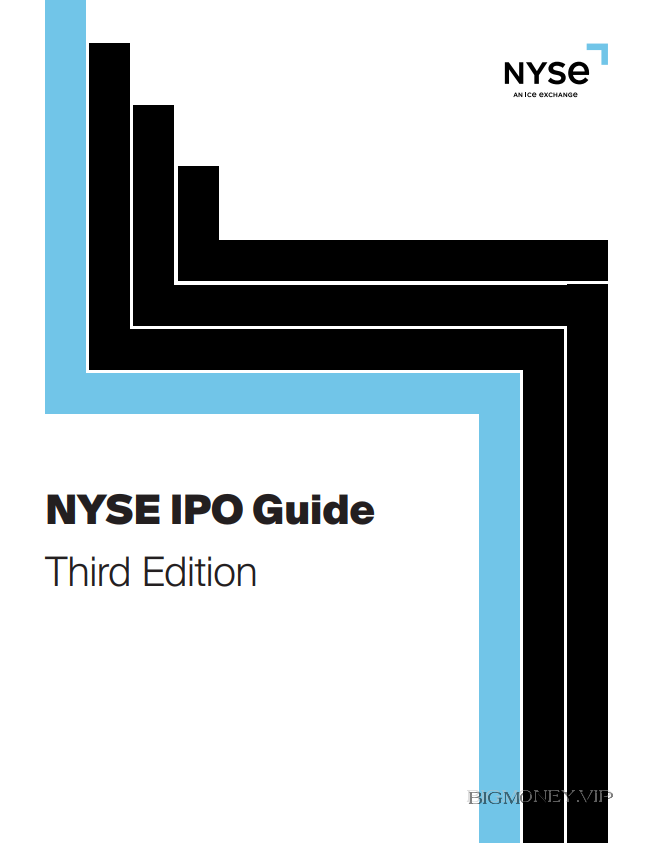NYSE IPO Guide Third Edition

1
Why go public?
1.1 Advantages of conducting an IPO
J.P. Morgan (Investment Banking)
When considering an IPO, a company
should evaluate the pros and cons, as
well as the motivations for going public.
This evaluation process is best conducted
in conjunction with an investment bank,
which can assist the company in thinking
through the key points. There are numerous
advantages to going public, the most
pertinent of which are detailed in the
following section.
(a) Access to capital
Going public affords a company access
to capital, both at the time of IPO and on
an ongoing basis. An IPO can consist of
primary and/or secondary proceeds. A
company can raise primary capital to fund
growth, make investments and/or repay
debt. An IPO can also provide liquidity
to existing investors and give them an
opportunity to sell stock.
Additionally:
■ Once the company is public, it has
access to an entirely new, deep and
liquid source of capital for
any future needs it may have.
■ Being publicly traded adds equity to
the company’s capital-raising toolkit,
enabling the company to achieve and
maintain an optimal capital structure
and potentially use stock as an
acquisition currency.
■ Following the IPO, the company will
be able to tap the equity markets via
follow-on offerings of primary and/or
secondary shares, or a mix thereof.
After the company has been public
for 12 months, it will be eligible to
access the equity capital markets
more efficiently via a shelf registration
statement.
(b) Liquidity event
Listing on the NYSE has numerous benefits,
not only for the company but also for its
shareholders. As previously mentioned, the
IPO can be structured such that existing
owners of the company can sell down their
positions and receive proceeds for their
shares. In addition, once the company is
public, the existing owners can monetize
their holdings in an efficient fashion
(c) Branding event and prestige
An IPO is a significant branding event.
By listing on the NYSE, the company will
receive far-reaching media coverage,
starting on the first day of trading if not
before. Subsequent to the IPO, research
analysts will begin to write reports on the
company, further raising its profile. This can
enhance the company’s visibility, increase
its credibility with existing and potential
customers and suppliers
and help strengthen its competitive
position.
(d) Public currency for acquisitions
Once the company is public, it can use its
publicly tradable common stock in whole
or in part to acquire other companies in
conjunction with, or instead of, raising
additional capital. Publicly tradable stock
with a reference price is more attractive
to target shareholders than illiquid private
company stock, which is more difficult to
value.
(e) Enhanced benefits for current
employees
Stock-based compensation aligns
employees’ interests with those of the
company and its public shareholders. By
allowing employees to benefit alongside
the company’s financial success, these
programs increase productivity and
loyalty to the company and serve as a key
selling mechanism when attracting top
talent. Furthermore, issuing equity-based
compensation will allow the company to
attract top talent without incurring additional
cash expenses. Being a public company
provides employees with the ability to
monetize the value of their stock-based
compensation, whether it is options or
restricted stock.
1.2 Potential issues
J.P. Morgan (Investment Banking)
While there are numerous advantages
to going public, there are also several
considerations that the company, its
management and its shareholders
should evaluate prior to embarking on the
IPO process. The most seamless IPO
processes are for companies that fully
evaluate these considerations before
embarking on an IPO and begin making
the necessary preparations months, if not
years, beforehand.
(a) Loss of privacy and flexibility
Private companies can operate without
disclosing proprietary information in a
public forum. However, to comply with
securities laws, public companies must
disclose potentially sensitive information
publicly, which regulatory agencies, as
well as competitors, can then access. In
addition, the focus of research analysts
and investors on quarterly results and
stock price performance may constrain
the operational flexibility that a private
company enjoys.
(b) Regulatory requirements and
potential liability
Public companies must file various reports
with the SEC and other regulators on an
ongoing basis. In order to comply with
disclosure requirements, companies often
need to change or expand their existing
policies and infrastructure, which can be
costly and time-consuming. In addition,
directors and officers are potentially
liable for misstatements and omissions
in the registration statement and in the
company’s ongoing reporting under the
Securities Exchange Act of 1934 (the
Exchange Act).
(c) Sarbanes-Oxley
The Sarbanes-Oxley (SOX) Act was
passed in 2002 following a number of
major corporate and accounting scandals,
which cost investors billions of dollars and
shook public confidence in US securities’
controls and disclosure. SOX set new
standards for public companies, including
requirements relating to accounting,
corporate governance, internal controls
and enhanced financial disclosure.
Achieving SOX compliance can require
significant time, resources and capital.
Although the JOBS Act relieves emerging
growth companies (EGCs) and SEC rule
updates in 2020 relieve smaller reporting
companies (SRCs) of the obligation to
have their independent auditors provide
an attestation on internal controls under
Section 404(b), they are still required to
put in place internal controls sufficient for
management to provide the certifications
required by Section 404(a)




